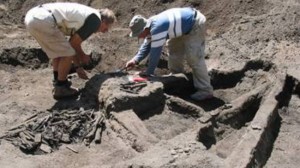Archaeology: Indonesia, beneath the volcanic ash Ancient a lost kingdom is discovered
Archaeologists have discovered ancient houses as well as precious artifacts and jewels from a buried kingdom, beneath the volcanic ash in Indonesia.

The excavated remains were found on the Indonesian island of Sumbawa near the foot of the Tambora volcano known for its largest eruption in recorded history.
“Based on the unearthed remains, particularly the many bronze objects and jewels, evidence suggests the site was once inhabited by the wealthy or elite who had grown prosperous through trade,” said a member of the investigative team and a PhD candidate with Bristol University in UK Emma Johnston.
“We know from the excavations and deposit stratigraphy that the houses were mostly inhabited when the accumulating pumice fall led to the collapse of the houses, trapping and killing those inside,” she explained.
The design and decoration of the discovered artifacts suggest a link between the Tamboran culture and that of Vietnam and Cambodia, the experts claimed.
The Tamborans historically were known in the East Indies for their honey, horses, red dye and sandalwood.
In 2004, an archaeological team discovered pottery fragments and bones that belonged to the Tamboran culture in the volcanic area near the little village of Pancasila.
The recent excavation is in continuation of the 2006 project under the leading of Dr M. Geria of the Bali Institute for Archaeology.
The experts hope to learn more about the buried kingdom, with an estimated population of about 10,000 people, and gain more data about the flow of events that led to their death.

